JVC GR-DVX44, GR-DVX77EG, GR-DVX77EK, GR-DVX88EG Service Manual
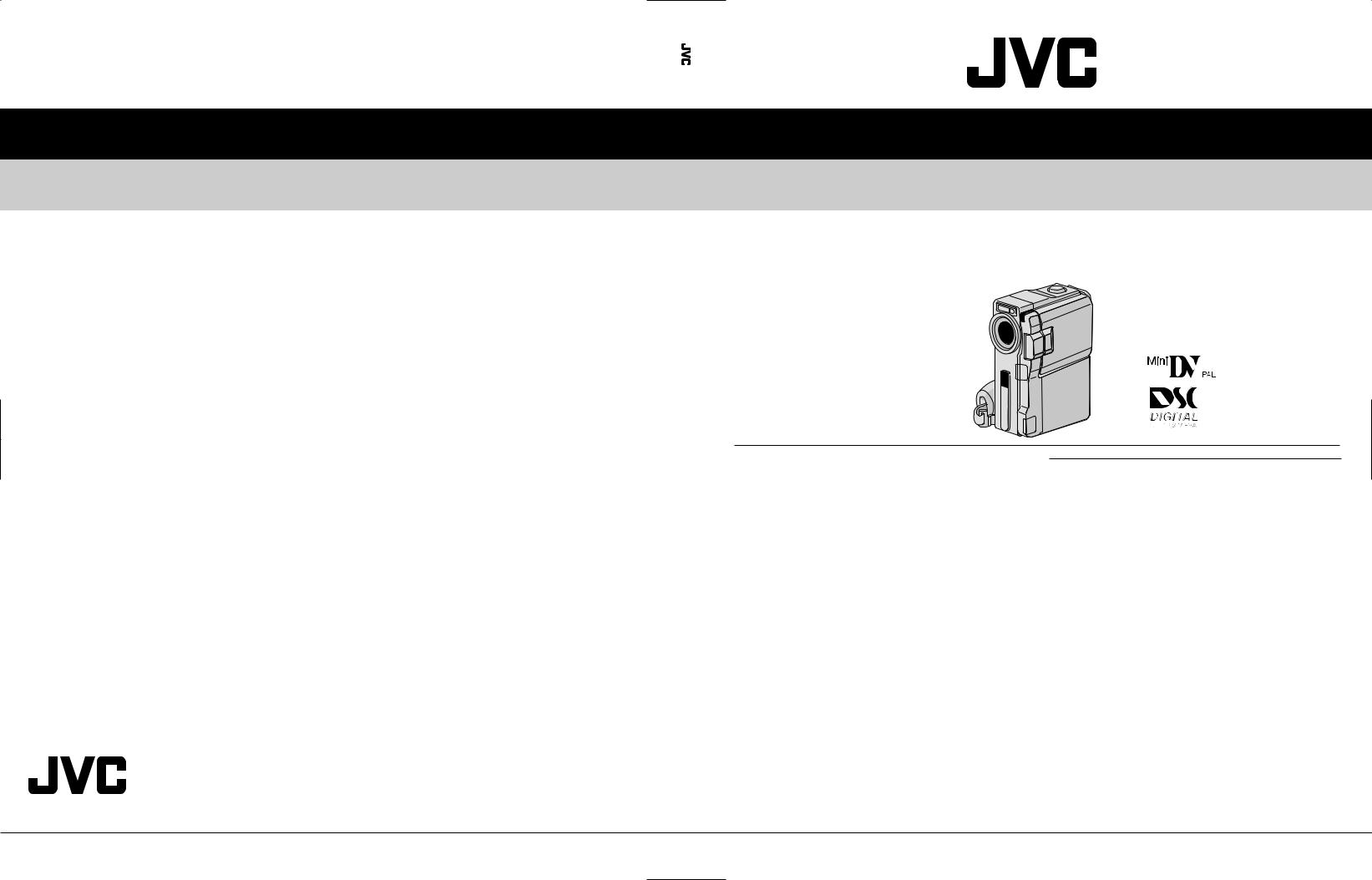
DVDVX44EG/EK,DVX77EG/EK,DVX88EG-GR
86617 .No
VICTOR COMPANY OF JAPAN, LIMITED |
S40894 |
VIDEO DIVISION |
 Printed in Japan
Printed in Japan
SERVICE MANUAL
DIGITAL VIDEO CAMERA
GR-DVX44EG/EK,DVX77EG/EK,DVX88EG
SPECIFICATIONS
|
Camcorder |
|
For General |
|
|
Power supply |
: DC 11.0 V } (Using AC Adapter) |
|
Power consumption |
DC 7.2 V } (Using battery pack) |
|
: Approx. 4.4 W (GR-DVX88/DVX77), Approx. 4.0 W (GR-DVX44) |
||
LCD monitor off, viewfinder on |
||
LCD monitor on, viewfinder off |
: Approx. 5.2 W (GR-DVX88/DVX77), Approx. 4.8 W (GR-DVX44) |
|
Dimensions (W x H x D) |
: 51 mm x 120 mm x 97 mm |
|
|
(with the LCD monitor closed and the viewfinder pushed back in) |
|
Weight |
: Approx. 500 g (GR-DVX88/DVX77) |
|
|
Approx. 470 g (GR-DVX44) |
|
Operating temperature |
: 0°C to 40°C |
|
Operating humidity |
: 35% to 80% |
|
Storage temperature |
: –20°C to 50°C |
|
Pickup |
: 1/4" CCD |
|
Lens |
: F 1.8, f = 3.6 mm to 36 mm, 10:1 power zoom lens |
|
Filter diameter |
: ø27 mm |
|
LCD monitor |
: 2.5" diagonally measured, LCD panel/TFT active matrix system |
|
Viewfinder |
: Electronic viewfinder with 0.44" colour LCD |
|
Speaker |
: Monaural |
|
For Digital Video Camera |
|
|
Format |
: DV format (SD mode) |
|
Signal format |
: PAL standard |
|
Recording/Playback format |
: Video: Digital component recording |
|
|
: Audio: PCM digital recording, 32 kHz 4-channel (12-bit), |
|
|
48 kHz 2-channel (16-bit) |
|
Cassette |
: Mini DV cassette |
|
Tape speed |
: SP: 18.8 mm/s |
|
|
LP: 12.5 mm/s |
|
Maximum recording time |
: SP: 80 min. |
|
(using 80 min. cassette) |
LP: 120 min. |
|
For Digital Still Camera (GR-DVX88/DVX77 only) |
||
Storage media |
: SD Memory Card/MultiMediaCard |
|
Compression system |
: Still image : JPEG (compatible) |
|
Moving image : MPEG4 (compatible) |
||
File size |
: 2 modes (XGA: 1024 x 768 pixels/VGA: 640 x 480 pixels) |
|
Picture quality |
: 2 modes (FINE/STANDARD) |
|
Approximate number of storable images
(with the provided memory card [8 MB], with Sound Effects pre-stored)
FINE |
: 40 (VGA), 20 (XGA) |
STANDARD |
: 130 (VGA), 60 (XGA) |
(with an optional memory card [16 MB]) |
|
FINE |
: 100 (VGA), 40 (XGA) |
STANDARD |
: 290 (VGA), 140 (XGA) |
(with an optional memory card [32 MB]) |
|
FINE |
: 210 (VGA), 90 (XGA) |
STANDARD |
: 610 (VGA), 290 (XGA) |
(with an optional memory card [64 MB]) |
|
FINE |
: 430 (VGA), 190 (XGA) |
STANDARD |
: 1230 (VGA), 600 (XGA) |
For Connectors
AV |
: 1 V (p-p), 75 Ω, analogue |
Video output |
|
Audio output |
: 300 mV (rms), 1 kΩ, analogue, stereo |
Headphone output |
|
(GR-DVX88/DVX77 only) |
: Stereo |
DV |
|
Input/output |
|
(GR-DVX88 only) |
: 4-pin, IEEE 1394 compliant |
Output |
|
(GR-DVX77/DVX44 only) |
: 4-pin, IEEE 1394 compliant |
|
AC adapter AP-V10EG |
Power requirement |
: AC 110 V to 240 V`, 50 Hz/60 Hz |
Output |
: DC 11 V } , 1 A |
Dimensions (W x H x D) |
: 59 mm x 31 mm x 84 mm |
Weight |
: Approx. 140 g (not including Power Cord) |
|
|
Jack Box |
For General |
|
|
Dimensions (W x H x D) |
: 52 mm x 22 mm x 73 mm |
|
Weight |
: Approx. 35 g |
|
For Connectors |
|
|
USB (GR-DVX88/DVX77 only) |
: Type B |
|
EDIT (GR-DVX88/DVX77 only) |
: ø3.5 mm, 2-pole |
|
S-Video |
|
: 1 V (p-p), 75 Ω, analogue |
Output |
: Y |
|
|
C |
: 0.29 V (p-p), 75 Ω, analogue |
JLIP (GR-DVX44 only) |
: ø3.5 mm, 4-pole |
|
PC (DIGITAL PHOTO) |
|
|
(GR-DVX44 only) |
: ø2.5 mm, 3-pole |
|
Specifications shown are for SP mode unless otherwise indicated. E & O.E. Design and specifications subject to change without notice.
This service manual is printed on 100% recycled paper. |
No. 86617 |
COPYRIGHT © 2001 VICTOR COMPANY OF JAPAN, LTD. |
April 2001 |

TABLE OF CONTENTS
Section |
Title |
Page |
||
Important Safety Precautions |
|
|||
INSTRUCTIONS |
|
|
||
1. |
DISASSEMBLY |
|
|
|
1.1 |
BEFORE ASSEMBLY AND DISASSEMBLY ........................ |
1-1 |
||
1.1.1 |
Precautions ..................................................................... |
|
1-1 |
|
1.1.2 |
Assembly and disassembly ............................................. |
1-1 |
||
1.1.3 Destination of connectors ................................................. |
1-1 |
|||
1.1.4 |
Disconnection of Connectors (Wires) .............................. |
1-1 |
||
1.2 |
JIGS AND TOOLS REQUIRED FOR DISASSEMBLY, |
|
||
|
ASSEMBLY AND ADJUSTMENT ......................................... |
1-2 |
||
1.2.1 |
Tools required for adjustments ........................................ |
1-2 |
||
1.3 |
DISASSEMBLY/ASSEMBLY OF CABINET PARTS AND |
|
||
|
BOARD ASSEMBLY |
............................................................. |
1-2 |
|
1.3.1 |
Disassembly flow chart .................................................... |
1-2 |
||
1.3.2 |
Disassembly method ....................................................... |
1-3 |
||
1.4 |
DISASSEMBLY OF 5 MONITOR ASSEMBLY ..................... |
1-8 |
||
1.4.1 |
5 Monitor assembly/Hinge assembly .............................. |
1-8 |
||
1.4.2 |
Hinge assembly ............................................................... |
|
1-8 |
|
1.5 |
DISASSEMBLY OF 7 OP BLOCK ASSEMBLY/CCD BOARD |
|||
|
ASSEMBLY ........................................................................... |
|
1-9 |
|
1.5.1 |
Precautions ..................................................................... |
|
1-9 |
|
1.5.2How to remove OP block assembly and CCD board assembly 1-9
1.5.3How to install OP block assembly and CCD board assembly 1-9
1.5.4 |
Replacement of service parts .......................................... |
1-9 |
|
1.6 |
DISASSEMBLY OF 9 E. VF ASSEMBLY ........................... |
1-10 |
|
1.6.1 |
9 E. VF assembly .......................................................... |
1-10 |
|
1.7 |
EMERGENCY DISPLAY .................................................... |
1-11 |
|
1.8 |
SERVICE NOTE ................................................................. |
1-12 |
|
2. |
MECHANISM ADJUSTMENT |
|
|
2.1 |
PRELIMINARY REMARKS ON ADJUSTMENT AND REPAIR 2-1 |
||
2.1.1 |
Precautions ..................................................................... |
2-1 |
|
2.1.2 |
Notes on procedure for disassemby/assembly ................ |
2-1 |
|
2.2 |
JIGS AND TOOLS REQUIRED FOR DISASSEMBLY, |
|
|
|
ASSEMBLY AND ADJUSTMENT ......................................... |
2-2 |
|
2.2.1 |
Tools required for adjustments ........................................ |
2-2 |
|
2.3 |
DISASSEMBLY/ASSEMBLY OF MECHANISM ASSEMBLY 2-3 |
||
2.3.1 |
General statement ........................................................... |
2-3 |
|
2.3.2 |
Explanation of mechanism mode .................................... |
2-3 |
|
2.3.3 |
Mechanism timing chart .................................................. |
2-4 |
|
2.4 |
DISASSEMBLY/ASSEMBLY OF MECHANISM ASSEMBLY 2-5 |
||
2.4.1 |
Follow chart ..................................................................... |
2-5 |
|
2.4.2 |
Disassembly/assembly .................................................... |
2-8 |
|
2.4.3 |
List of procedures for disassembly ................................ |
2-14 |
|
2.5 |
CHECKUP AND ADJUSTMENT OF MECHANISM PHASE 2-15 |
||
2.6 |
MECHANISM ADJUSTMENTS .......................................... |
2-16 |
|
2.6.1 |
Assembling slide deck assembly and main deck assembly . 2-16 |
||
2.6.2 |
Locating tension pole .................................................... |
2-17 |
|
2.7 |
SERVICE NOTE .................................................................. |
2-18 |
|
2.8 |
JIG CONNECTOR CABLE CONNECTION ........................ |
2-20 |
|
3. |
ELECTRICAL ADJUSTMENT |
|
|
3.1 |
Precaution ............................................................................ |
3-1 |
|
3.2 |
SETUP ................................................................................. |
3-2 |
|
4. |
CHARTS AND DIAGRAMS |
|
|
NOTES OF SCHEMATIC DIAGRAM .......................................... |
4-1 |
||
CIRCUIT BOARD NOTES ........................................................... |
4-2 |
||
4.1 |
BOARD INTERCONNECTIONS [GR-DVX44EG/EK] ........... |
4-3 |
|
4.2 |
BOARD INTERCONNECTIONS |
|
|
|
[GR-DVX77EG/EK, GR-DVX88EG] ...................................... |
4-5 |
|
4.3 |
SYSCON SCHEMATIC DIAGRAM [GR-DVX44EG/EK] ....... |
4-7 |
|
4.4 |
SYSCON SCHEMATIC DIAGRAM |
|
|
|
[GR-DVX77EG/EK, GR-DVX88EG] ...................................... |
4-9 |
|
4.5 |
PC IF SCHEMATIC DIAGRAM [GR-DVX44EG/EK] ........... |
4-11 |
|
Section |
Title |
Page |
|
4.6 |
PC IF SCHEMATIC DIAGRAM |
|
|
|
[GR-DVX77EG/EK, GR-DVX88EG] .................................... |
4-13 |
|
4.7 |
DVMAIN SCHEMATIC DIAGRAM [GR-DVX44EG/EK] ...... |
4-15 |
|
4.8 |
DVMAIN SCHEMATIC DIAGRAM |
|
|
|
[GR-DVX77EG/EK, GR-DVX88EG] .................................... |
4-17 |
|
4.9 |
SERVO SCHEMATIC DIAGRAM ........................................ |
4-19 |
|
4.10 |
PRE/REC SCHEMATIC DIAGRAM ................................. |
4-21 |
|
4.11 V OUT SCHEMATIC DIAGRAM [GR-DVX44EG/EK] ....... |
4-23 |
||
4.12 V OUT SCHEMATIC DIAGRAM |
|
||
|
[GR-DVX77EG/EK, GR-DVX88EG] ................................. |
4-25 |
|
4.13CAM DSP SCHEMATIC DIAGRAM [GR-DVX44EG/EK] . 4-27
4.14CAM DSP SCHEMATIC DIAGRAM
|
[GR-DVX77EG/EK, GR-DVX88EG] ................................. |
4-29 |
4.15 |
ANA IN SCHEMATIC DIAGRAM |
|
|
[THIS SCHEMATIC DIAGRAM IS NOT USED] ............... |
4-31 |
4.16 |
TG/V.DRV SCHEMATIC DIAGRAM ................................. |
4-33 |
4.17 |
REG SCHEMATIC DIAGRAM .......................................... |
4-35 |
4.18 |
STO SENS SCHEMATIC DIAGRAM |
|
|
[GR-DVX77EG/EK, GR-DVX88EG] ................................. |
4-37 |
4.19 |
VF MAIN SCHEMATIC DIAGRAM ................................... |
4-39 |
4.20 |
DSC SCHEMATIC DIAGRAM |
|
|
[GR-DVX77EG/EK, GR-DVX88EG] ................................. |
4-41 |
4.21MP3 SCHEMATIC DIAGRAM [GR-DVX77EG/EK, GR-DVX88EG] . 4-43
4.22USB DRV SCHEMATIC DIAGRAM
|
[GR-DVX77EG/EK, GR-DVX88EG] ................................. |
4-45 |
4.23 |
W/B SCHEMATIC DIAGRAM ........................................... |
4-47 |
4.24 |
CCD SCHEMATIC DIAGRAM .......................................... |
4-48 |
4.25 |
MDA SCHEMATIC DIAGRAM .......................................... |
4-49 |
4.26 |
IR TALLY SCHEMATIC DIAGRAM ................................... |
4-51 |
4.27 |
OP DRIVER SCHEMATIC DIAGRAM .............................. |
4-53 |
4.28 |
MONITOR SCHEMATIC DIAGRAM ................................. |
4-55 |
4.29 |
JUNCTION SCHEMATIC DIAGRAM ............................... |
4-57 |
4.30 |
STROBE SCHEMATIC DIAGRAM |
|
|
[GR-DVX77EG/EK, GR-DVX88EG] ................................. |
4-59 |
4.31 |
AUDIO AD/DA SCHEMATIC DIAGRAM .......................... |
4-61 |
4.32 |
MAIN AUDIO SCHEMATIC DIAGRAM ............................ |
4-63 |
4.33 |
A/HP SEL. SCHEMATIC DIAGRAM ................................ |
4-65 |
4.34 |
JACK SCHEMATIC DIAGRAM ........................................ |
4-67 |
4.35 |
WB SENS, CAMERA OPE. UNIT, DECK OPE. ASSY |
|
|
AND SUB OPE. UNIT SCHEMATIC DIAGRAMS ............ |
4-69 |
4.36 |
MAIN CIRCUIT BOARD [GR-DVX44EG/EK] ................... |
4-71 |
4.37 |
MAIN CIRCUIT BOARD [GR-DVX77EG/EK, GR-DVX88EG] . 4-77 |
|
4.38 |
MDA CIRCUIT BOARD .................................................... |
4-83 |
4.39 |
CCD AND JUNCTION CIRCUIT BOARDS ...................... |
4-85 |
4.40 |
MONITOR CIRCUIT BOARD ........................................... |
4-87 |
4.41 |
AUDIO CIRCUIT BOARD ................................................ |
4-89 |
4.42 |
STROBE, W/B AND JACK CIRCUIT BOARDS ............... |
4-91 |
4.43 |
VOLTAGE CHARTS ......................................................... |
4-93 |
4.44 |
POWER SYSTEM BLOCK DIAGRAM ............................. |
4-97 |
4.45 |
VIDEO SYSTEM BLOCK DIAGRAM ............................... |
4-99 |
5. PARTS LIST |
|
|
5.1 |
PACKING AND ACCESSORY ASSEMBLY <M1> ............... |
5-1 |
5.2 |
FINAL ASSEMBLY <M2> .................................................... |
5-2 |
5.3 |
MECHANISM ASSEMBLY <M3> ........................................ |
5-6 |
5.4 |
ELECTRONIC VIEWFINDER ASSEMBLY <M4> ................ |
5-8 |
5.5 |
MONITOR ASSEMBLY <M5> ............................................. |
5-9 |
5.6 |
ELECTRICAL PARTS LIST ................................................ |
5-10 |
MAIN BOARD ASSEMBLY <01> ............................................. |
5-10 |
|
MDA BOARD ASSEMBLY <02> .............................................. |
5-19 |
|
CCD BOARD ASSEMBLY <03> .............................................. |
5-20 |
|
MONITOR BOARD ASSEMBLY <04> ..................................... |
5-20 |
|
JUNCTION BOARD ASSEMBLY <06> ................................... |
5-21 |
|
STROBE BOARD ASSEMBLY(C,D,E) ..................................... |
5-21 |
|
AUDIO BOARD ASSEMBLY <08> .......................................... |
5-22 |
|
JACK BOARD ASSEMBLY <09> ............................................. |
5-24 |
|
W/B BOARD ASSEMBLY <11> ............................................... |
5-24 |
|
The following table lists the differing points between Models GR-DVX44EG/EK, GR-DVX77EG/EK and GR-DVX88EG in this series.
|
GR-DVX44EG |
|
GR-DVX44EK |
GR-DVX77EG |
GR-DVX77EK |
GR-DVX88EG |
|
|
|
|
|
|
|
VIDEO FLASH |
|
|
|
|
|
|
DSC FLASH MEMORY |
NOT USED |
|
USED |
|
||
DIGITAL SOUND RECODING |
|
|
|
|
|
|
DV INPUT |
|
|
NOT USED |
|
USED |
|
HEAD PHONE OUTPUT |
NOT USED |
|
USED |
|
||
MEMORY CARD |
NOT USED |
|
USED (8 MB) |
|
||
JACK BOX |
CU-V505 |
|
CU-V506 |
|
||
USB CABLE |
NOT USED |
|
USED |
|
||
USB TERMINAL |
|
|
||||
|
|
|
|
|
|
|
PC CONNECTION CABLE |
|
USED |
|
NOT USED |
|
|
JLIP/EDIT TERMINAL |
|
|
|
|||
|
|
|
|
|
|
|
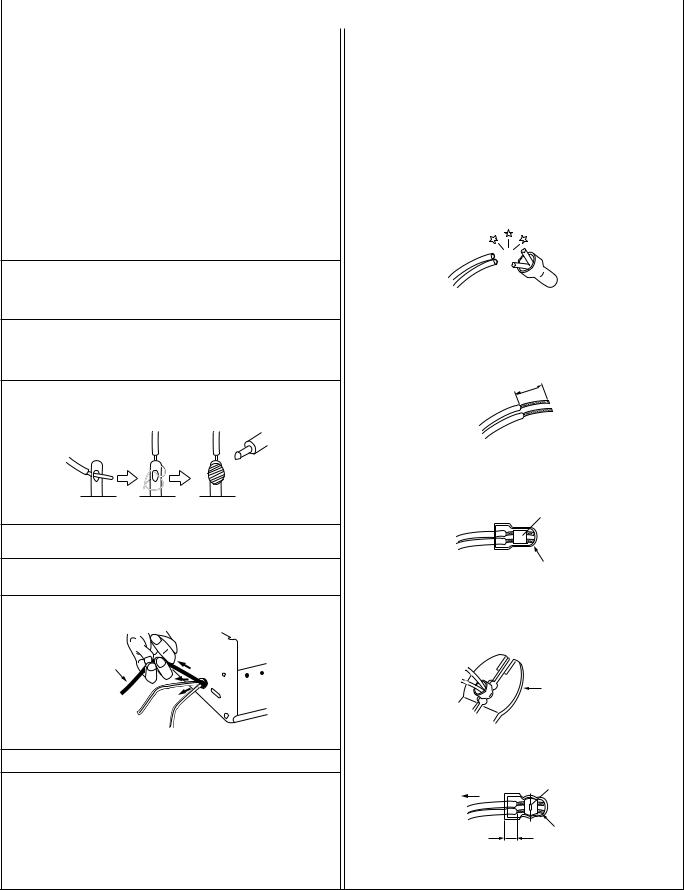
Important Safety Precautions
Prior to shipment from the factory, JVC products are strictly inspected to conform with the recognized product safety and electrical codes of the countries in which they are to be sold. However, in order to maintain such compliance, it is equally important to implement the following precautions when a set is being serviced.
•Precautions during Servicing |
|
||
1. Locations requiring special caution are denoted by labels and in- |
12. Crimp type wire connector |
||
scriptions on the cabinet, chassis and certain parts of the product. |
In such cases as when replacing the power transformer in sets |
||
When performing service, be sure to read and comply with these |
where the connections between the power cord and power trans- |
||
and other cautionary notices appearing in the operation and serv- |
former primary lead wires are performed using crimp type connec- |
||
ice manuals. |
|
|
tors, if replacing the connectors is unavoidable, in order to prevent |
|
|
|
safety hazards, perform carefully and precisely according to the |
2. Parts identified by the ! symbol and shaded ( |
|
|
|
|
) parts are |
following steps. |
|
|
|||
critical for safety. |
|
|
1) Connector part number : E03830-001 |
Replace only with specified part numbers. |
|
|
|
Note: Parts in this category also include those specified to com- |
2) Required tool : Connector crimping tool of the proper type which |
||
ply with X-ray emission standards for products using |
will not damage insulated parts. |
||
cathode ray tubes and those specified for compliance |
3) Replacement procedure |
||
with various regulations regarding spurious radiation |
(1) Remove the old connector by cutting the wires at a point |
||
emission. |
|
|
close to the connector. |
|
|
|
Important : Do not reuse a connector (discard it). |
3.Fuse replacement caution notice.
Caution for continued protection against fire hazard. Replace only with same type and rated fuse(s) as specified.
4. |
Use specified internal wiring. Note especially: |
|
|
|
|
|
|
1) Wires covered with PVC tubing |
|
|
|
|
|
|
2) Double insulated wires |
|
|
cut close to connector |
||
|
3) High voltage leads |
|
|
|
Fig.3 |
|
|
|
|
|
|
|
|
5. |
Use specified insulating materials for hazardous live parts. Note |
(2) Strip about 15 mm of the insulation from the ends of the |
||||
|
especially: |
|
|
|||
|
1) Insulation Tape |
3) Spacers |
5) Barrier |
wires. If the wires are stranded, twist the strands to avoid |
||
|
2) PVC tubing |
4) Insulation sheets for transistors |
frayed conductors. |
|
|
|
6. |
When replacing AC primary side components (transformers, power |
|
15 mm |
|
||
|
|
|
||||
|
cords, noise blocking capacitors, etc.) wrap ends of wires securely |
|
|
|
||
|
about the terminals before soldering. |
|
|
|
|
|
|
|
|
|
|
Fig.4 |
|
|
|
|
|
(3) Align the lengths of the wires to be connected. Insert the |
||
|
|
|
|
wires fully into the connector. |
|
|
|
|
Fig.1 |
|
|
Metal sleeve |
|
7. |
Observe that wires do not contact heat producing parts (heatsinks, |
|
|
|
||
|
oxide metal film resistors, fusible resistors, etc.) |
|
|
|
|
|
8. |
Check that replaced wires do not contact sharp edged or pointed |
|
Connector |
|||
|
parts. |
|
|
|
Fig.5 |
|
|
|
|
|
|
|
|
9. |
When a power cord has been replaced, check that 10-15 kg of |
(4) As shown in Fig.6, use the crimping tool to crimp the metal |
||||
|
force in any direction will not loosen it. |
|
||||
|
|
sleeve at the center position. Be sure to crimp fully to the |
||||
|
|
|
|
|||
|
|
|
|
complete closure of the tool. |
|
|
|
Power cord |
|
|
|
|
|
|
|
|
|
|
1. |
Crimping tool |
|
|
|
|
|
25 |
|
|
|
|
|
2. |
|
|
|
|
|
|
5. |
0 |
|
|
|
|
|
|
|
|
|
|
|
|
5 |
|
|
|
|
Fig.2 |
|
|
Fig.6 |
|
10. |
Also check areas surrounding repaired locations. |
|
(5) Check the four points noted in Fig.7. |
|||
11. |
Products using cathode ray tubes (CRTs) |
|
Not easily pulled free |
Crimped at approx. center |
||
|
|
of metal sleeve |
||||
|
In regard to such products, the cathode ray tubes themselves, the |
|
|
|||
|
|
|
|
|||
|
high voltage circuits, and related circuits are specified for compli- |
|
|
|
||
|
ance with recognized codes pertaining to X-ray emission. |
|
|
|
||
|
Consequently, when servicing these products, replace the cath- |
|
|
Conductors extended |
||
|
ode ray tubes and other parts with only the specified parts. Under |
Wire insulation recessed |
|
|||
|
no circumstances attempt to modify these circuits. |
|
|
|||
|
|
more than 4 mm |
|
|||
|
Unauthorized modification can increase the high voltage value and |
|
||||
|
|
Fig.7 |
|
|||
|
cause X-ray emission from the cathode ray tube. |
|
|
|
||
I |
S40888-01 |
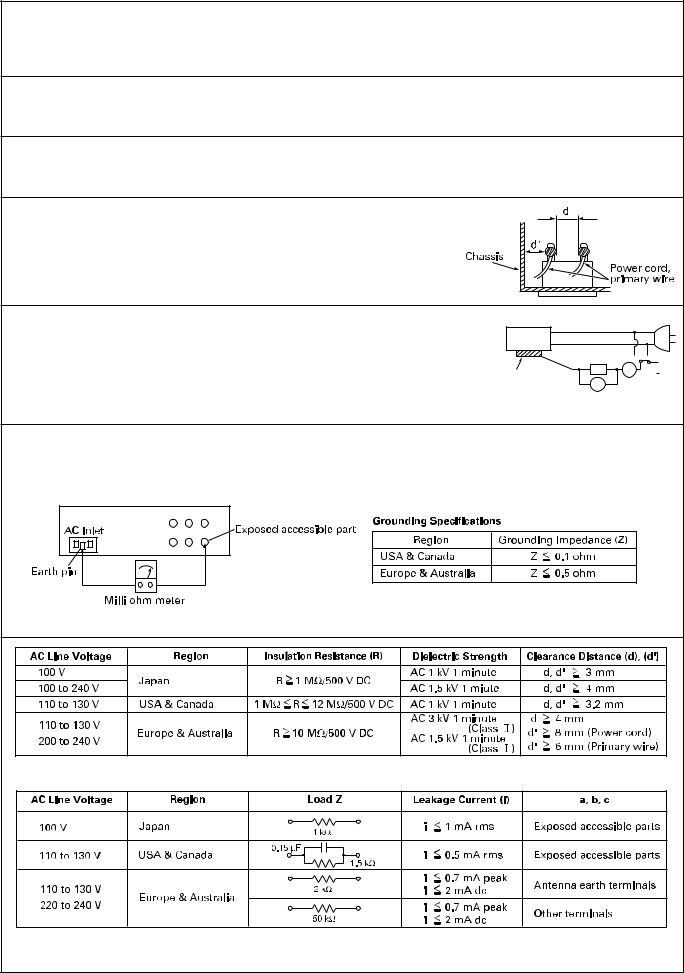
•Safety Check after Servicing
Examine the area surrounding the repaired location for damage or deterioration. Observe that screws, parts and wires have been returned to original positions, Afterwards, perform the following tests and confirm the specified values in order to verify compliance with safety standards.
1.Insulation resistance test
Confirm the specified insulation resistance or greater between power cord plug prongs and externally exposed parts of the set (RF terminals, antenna terminals, video and audio input and output terminals, microphone jacks, earphone jacks, etc.). See table 1 below.
2.Dielectric strength test
Confirm specified dielectric strength or greater between power cord plug prongs and exposed accessible parts of the set (RF terminals, antenna terminals, video and audio input and output terminals, microphone jacks, earphone jacks, etc.). See table 1 below.
3. Clearance distance
When replacing primary circuit components, confirm specified clearance distance (d), (d’) between soldered terminals, and between terminals and surrounding metallic parts. See table 1 below.
Fig. 8
4.Leakage current test
Confirm specified or lower leakage current between earth ground/power cord plug prongs and externally exposed accessible parts (RF terminals, antenna terminals, video and audio input and output terminals, microphone jacks, earphone jacks, etc.).
Measuring Method : (Power ON)
Insert load Z between earth ground/power cord plug prongs and externally exposed accessible parts. Use an AC voltmeter to measure across both terminals of load Z. See figure 9 and following table 2.
a
 b
b
Z A c 
Externally exposed V
accessible part
Fig. 9
5.Grounding (Class 1 model only)
Confirm specified or lower grounding impedance between earth pin in AC inlet and externally exposed accessible parts (Video in, Video out, Audio in, Audio out or Fixing screw etc.).
Measuring Method:
Connect milli ohm meter between earth pin in AC inlet and exposed accessible parts. See figure 10 and grounding specifications.
Fig. 10
Table 1 Specifications for each region
Table 2 Leakage current specifications for each region
Note: These tables are unofficial and for reference only. Be sure to confirm the precise values for your particular country and locality.
II |
S40888-01 |
|

SECTION 1
DISASSEMBLY
1.1 BEFORE ASSEMBLY AND DISASSEMBLY
1.1.1 Precautions
1.Be sure to remove the power supply unit prior to mounting and soldering of parts.
2.When removing a component part that needs to disconnect the connector and to remove the screw for removing itself, first disconnect the connecting wire from the connector and then remove the screw beforehand.
3.When connecting and disconnecting the connectors, be careful not to damage the wire.
4.Carefully remove and handle the part to which some spacer or shield is attached for reinforcement or insulation.
5.When replacing chip parts (especially IC parts), desolder completely first (to prevent peeling of the pattern).
6.Tighten screws properly during the procedures. Unless specified otherwise, tighten screws at a torque of 0.078N•m(0.8kgf•cm).
1.1.2Assembly and disassembly
STEP |
PART |
Fig.No. |
POINT |
NOTE |
||||||
No. |
||||||||||
|
|
|
|
|
|
|
|
|||
|
|
|
|
|
|
|
|
|
|
|
1 |
DECK OPE ASSY |
Fig.1-3-1 |
2(S1), (L1) |
— |
||||||
|
|
|
|
|
|
CN1a |
|
|
||
2 |
MIC UNIT |
|
|
2(S2),2(L2) |
NOTE2 |
|||||
|
|
|
|
|
|
CN2a |
|
|
||
3 |
FRONT COVER |
Fig.1-3-2 |
COVER(DV),(S3a),3(S3b) |
NOTE3a |
||||||
|
|
ASSY |
|
|
2(S3c),(S3d),STUD(HOOK) |
NOTE3b |
||||
|
|
|
|
|
|
(L3) |
|
|
||
|
|
|
|
|
|
CN3a |
|
|
||
|
|
|
|
|
|
|
|
|
|
|
|
|
|
|
|
|
|
|
|
|
|
(1) |
(2) |
(3) |
(4) |
(5) |
||||||
(1)Indicate the disassembly steps. When assembling, perform in the reverse order of these steps. This number corresponds to the number in the disassembly diagram.
(2)Indicates the name of disassembly/assembly parts.
(3)Indicates the number in the disassembly diagram.
(4)Indicates parts and points such as screws, washers, springs which must be removed during disassembly/ assembly.
Symbol |
Name, Point |
S |
Screw |
L |
Lock, Pawl, Hook |
SD |
Soldering |
(Others) |
Connector, Cover, Bracket, etc. |
(Example)
•2 (S1) : Remove the two screws (S1) for removing the part 1.
•CN 1a: Disconnect the connector 1a.
• SD1 : Unsolder at the point SD1.
(5) Precautions on disassembly/assembly.
1.1.3 Destination of connectors
Note: Three kinds of double-arrows in connection tables respectively show kinds of connector/wires.
↔ : Wire
: Flat wire (FPC, FFC)
 : Board to Board connector [Example]
: Board to Board connector [Example]
CONN. |
|
CONNECTOR |
|
Pin No. |
||
No. |
|
|
||||
|
|
|
|
|
|
|
|
|
|
|
|
|
|
1a |
DECK OPE ASSY |
- |
|
AUDIO |
CN803 |
6 |
2a |
AUDIO |
CN804 |
|
MIC UNIT |
- |
4 |
1.1.4 Disconnection of Connectors (Wires)
Connector
Pull both ends of the connector in the arrow direction, remove the lock and disconnect the flat wire.
Flat wire
Connector
Fig. 1-1-1 Connector 1
Extend the locks in the direction of the arrow for unlocking and then pull out the wire. After removing the wire, immediately restore the locks to their original positions because the locks are apt to come off the connector.
Flat wire 
Connector
Fig. 1-1-2 Connector 2
B-B connector
Pull the board by both the sides in the direction of the arrow for disconnecting the B-B connector.
Connector
Connector |
Fig. 1-1-3 Connector 3 |
Connector |
Fig. 1-1-4 Connector 4 |
1-1
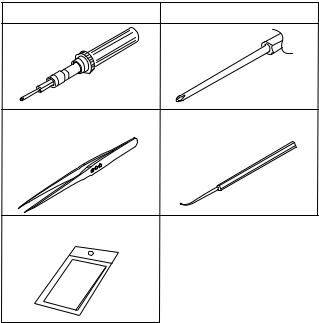
1.2JIGS AND TOOLS REQUIRED FOR DISASSEMBLY, ASSEMBLY AND ADJUSTMENT
1.2.1 Tools required for adjustments
1 |
Torque Driver |
2 |
Bit |
|
YTU94088 |
YTU94088-003 |
|||
|
|
3 |
Tweezers |
4 |
Chip IC Replacement Jig |
|
P-895 |
PTS40844-2 |
|||
|
|
5 |
Cleaning Cloth |
|
KSMM-01 |
||
|
Table 1-2-1
1.Torque driver
Be sure to use to fastening the mechanism and exterior parts because those parts must strictly be controlled for tightening torque.
2.Bit
This bit is slightly longer than those set in conventional torque drivers.
3.Tweezers
To be used for removing and installing parts and wires.
4.Chip IC replacement jig
To be used for adjustment of the camera system.
5.Cleaning cloth
Recommended cleaning cloth to wipe down the video heads, mechanism (tape transport system), optical lens surface.
1.3DISASSEMBLY/ASSEMBLY OF CABINET PARTS AND BOARD ASSEMBLY
1.3.1 Disassembly flow chart
This flowchart indicates the disassembly step for the cabinet parts and board assembly in order to gain access to item(s) to be serviced. When reassembling, perform the step(s) in reverse order.
1 |
DECK OPE ASSY |
||
|
|
||
|
|
|
|
2 |
MIC UNIT |
||
|
|
||
|
|
|
|
3 |
FRONT COVER ASSY |
||
|
|
||
|
|
|
|
4 |
UPPER CASE ASSY |
||
(Inc.MONITOR ASSY) |
|||
|
|||
|
|
||
|
|
|
|
5 |
MONITOR ASSY |
||
|
|
||
|
|
|
|
|
LOWER CASE ASSY |
||
6 |
(Inc.OP BLOCK ASSY |
||
/STROBE ASSY/E. VF UNIT |
|||
|
|||
|
/AUDIO BOARD ASSY) |
||
|
|
||
|
|
|
|
7 |
OP BLOCK ASSY |
||
|
|
||
|
|
|
|
8 |
STROBE ASSY |
||
|
|
||
|
|
|
|
9 |
E.VF ASSY |
||
|
|
||
|
|
|
|
0 |
AUDIO BOARD ASSY |
||
|
|
||
|
|
|
|
! |
MDA BOARD ASSY |
||
|
|
||
|
|
|
|
@ |
MAIN BOARD ASSY |
||
|
|
||
|
|
|
|
# |
MECHANISM ASSY |
||
|
|
||
|
Table 1-3-1 |
||
1-2
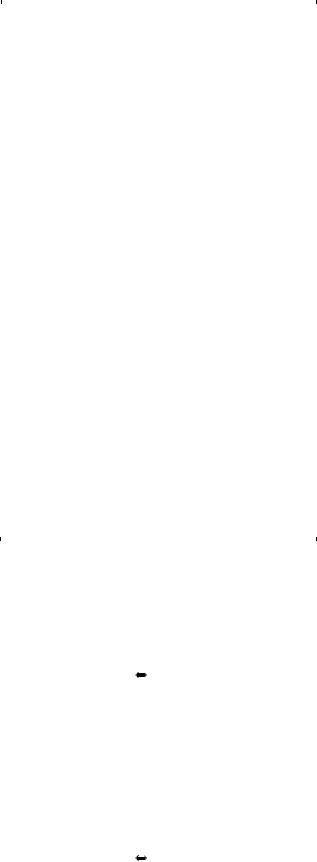
1.3.2 |
Disassembly method |
|
|||
STEP |
PART |
Fig.No. |
POINT |
NOTE |
|
No. |
|||||
|
|
|
|
||
|
|
|
|
|
|
1 |
DECK OPE ASSY |
Fig.1-3-1 |
2(S1), (L1) |
— |
|
|
|
|
CN 1a |
|
|
|
|
|
|
||
2 |
MIC UNIT |
|
2(S2), 2(L2) |
NOTE2 |
|
|
|||||
|
|
|
CN 2a |
|
|
3 |
FRONT COVER |
Fig.1-3-2 |
COVER(DV), (S3a), 3(S3b) |
NOTE3a |
|
|
ASSY |
|
2(S3c), (S3d), STUD(HOOK) |
NOTE3b |
|
|
|
|
(L3) |
|
|
|
|
|
CN 3a |
|
|
4 |
UPPER CASE ASSY |
Fig.1-3-3 |
(S4a), 2(L4), LOCK(MONITOR) |
NOTE4a |
|
|
(Inc.MONITOR |
|
(S4b), (S4c), (S4d), 2(S4e) |
NOTE4b |
|
|
ASSY) |
|
CN 4a, 4b, 4c, 4d |
NOTE4c |
|
5 |
MONITOR ASSY |
Fig.1-3-4 |
(S5a),(S5b) |
NOTE5 |
|
|
|
|
|
|
|
6 |
LOWER CASE ASSY |
Fig.1-3-5 |
CN 6a, 6b,6c, 6d, 6e |
NOTE6a |
|
|
(Inc.OP BLOCK ASSY |
|
(S6a), 4(S6b) |
NOTE6b |
|
|
/STROBE ASSY |
|
|
NOTE6c |
|
|
/E. VF ASSY |
|
|
|
|
|
/AUDIO BOARD |
|
|
|
|
|
ASSY) |
|
|
|
|
7 |
OP BLOCK ASSY |
Fig.1-3-6 |
2(S7),2(L7) |
NOTE7a |
|
|
|
|
|
NOTE7b |
|
|
|
|
|
NOTE7c |
|
8 |
STROBE ASSY |
Fig.1-3-7 |
(S8),GR-DVX77EG/EK,DVX88EG |
NOTE8 |
|
|
|
|
|
|
|
9 |
E.VF ASSY |
Fig.1-3-8 |
CN 9a, (9b) |
NOTE9a |
|
|
|
|
(S9), 2(L9) |
NOTE9b |
|
|
|
|
|
NOTE9c |
|
|
|
|
|
NOTE9d |
|
0 |
AUDIO BOARD ASSY |
Fig.1-3-9 |
SPACER,(S0a),3(S0b),(L0a) |
NOTE0a |
|
|
|
|
(L0b),BRACKET(TOP) |
NOTE0b |
|
! |
MDA BOARD ASSY |
Fig.1-3-10 |
CN !a, !b, !c, (S!) |
NOTE!a |
|
|
|
|
CN !d, !e |
NOTE!b |
|
|
|
|
|
NOTE!c |
|
@ |
MAIN BOARD ASSY |
|
(S@a), (L@), SHIELD PLATE |
NOTE@ |
|
|
|
|
CN @a, @b, (S@b) |
|
|
# |
MECHANISM ASSY |
|
(S#a), 2(S#b), 2(L#) |
— |
|
|
|
|
BRACKET(MECHA) |
|
|
|
|
|
|
|
|
Table 1-3-2
Note: Remove the parts marked in  .
.
CONN. |
|
CONNECTOR |
|
Pin No. |
||
No. |
|
|
||||
|
|
|
|
|
|
|
|
|
|
|
|
|
|
1a |
DECK OPE ASSY - |
|
AUDIO |
CN803 |
6 |
|
2a |
AUDIO |
CN804 |
←→ |
MIC UNIT |
- |
4 |
3a |
JACK |
CN901 |
|
MAIN |
CN103 |
18 |
4a |
MDA |
CN207 |
|
SUB OPE ASSY |
- |
7 |
4b |
MAIN |
CN104 |
←→ |
W/B |
- |
3 |
4c |
MAIN |
CN106 |
|
MONITOR |
CN761 |
45/39 |
4d |
MAIN |
CN112 |
|
J.BOX/MENU |
- |
16 |
6a |
MAIN |
CN101 |
|
AUDIO |
CN801 |
80 |
6b |
MAIN |
CN107 |
|
CCD |
- |
20 |
6c |
MAIN |
CN109 |
|
STROBE |
- |
12 |
6d |
MDA |
CN205 |
|
OP BLOCK ASSY |
- |
24 |
6e |
MAIN |
CN208 |
|
JUNCTION |
CN601 |
20 |
9a |
AUDIO |
CN805 |
|
E. VF ASSY |
CN1 |
16 |
9b |
AUDIO |
CN803 |
|
FPC |
- |
6 |
!a |
MDA |
CN202 |
|
DRUM MOTOR |
- |
11 |
!b |
MDA |
CN201 |
|
LOADING MOTOR |
- |
6 |
!c |
MDA |
CN203 |
|
CAPSTAN MOTOR |
- |
18 |
!d |
MAIN |
CN102 |
|
MDA |
CN206 |
80 |
!e |
MDA |
CN204 |
|
SENSOR |
- |
15 |
@a |
MAIN |
CN110 |
|
HEAD |
- |
8 |
@b |
MAIN |
CN111 |
|
ROTARY ENCODER |
- |
6 |
|
|
|
|
|
|
|
Table 1-3-3
NOTE 2: Beware of electrical shock due to the capacitor during work.
(GR-DVX77EG/EK and GR-DVX88EG)
NOTE 3a: When disassembling the Front Cover Assembly, remove the screws, pull out the studs and free the grip belt.
NOTE 3b: When attaching the assembly, make sure that the strobe block fits properly into the frame.
(GR-DVX77EG/EK and GR-DVX88EG)
NOTE 4a: Remove the Upper Case Assembly before removing the Monitor Assembly 5.
NOTE 4b: Take care not to damage the parts (battery terminals).
NOTE 4c: Take care not to damage the parts (spring).
NOTE 5: Refer to Fig. 1-4-1 for the disassembly method.
NOTE 6a: Remove the board assemblies (Main/MDA) and Mechanism Assembly together.
NOTE 6b: When removing, take care not to disconnect the wire or damage any of the parts.
NOTE 6c: When attaching, be careful of the board attaching position.
NOTE 7a: Remove the OP Block Assembly together with the Strobe Assembly. Beware of electrical shock due to the capacitor during work.
(GR-DVX77EG/EK and GR-DVX88EG)
NOTE 7b: When removing, take care not to disconnect the wire or damage any of the parts.
NOTE 7c: Refer to Fig. 1-5-1 for the disassembly method.
NOTE 8: Beware of electrical shock due to the capacitor during work.
(GR-DVX77EG/EK and GR-DVX88EG)
NOTE 9a: When removing, be careful with the FPC (for the Deck
Operation Assembly) attached inside the E.VF Assembly.
Remove the FPC by unplugging it from the connector and then taking the FPC out together with the E. VF or by peeling it carefully so that the double-sided adhesive can be reused later.
NOTE 9b: When removing or attaching, take care not to damage any parts.
Particularly, when attaching the switch, always pull out the E.VF Assembly to avoid it from damaging the switch.
NOTE 9c: When attaching, be careful with the wire treatment.
NOTE 9d: Refer to Fig. 1-6-1 for the disassembly method.
NOTE 0a: When attaching or removing, take care not to damage any parts.
Attach the slide switch at the position of the DSC switch (VIDEO side).
(GR-DVX77EG/EK and GR-DVX88EG)
NOTE 0b: When attaching, take care with the wire treatment.
This note does not apply when the E.VF Assembly and FPC have been removed together as shown in Fig. 1-3- 8.
NOTE !a: When unplugging the connector !d, be careful with the handling of the FPC connected to it.
NOTE !b: Connector !e is located inside the circuit board, so it should be the last item to be removed.
NOTE !c, @: When attaching, pay heed to the FPC treatment.
Mount the FPC so that it is caught between the Mechanism Assembly and the Main Board Assembly.
1-3
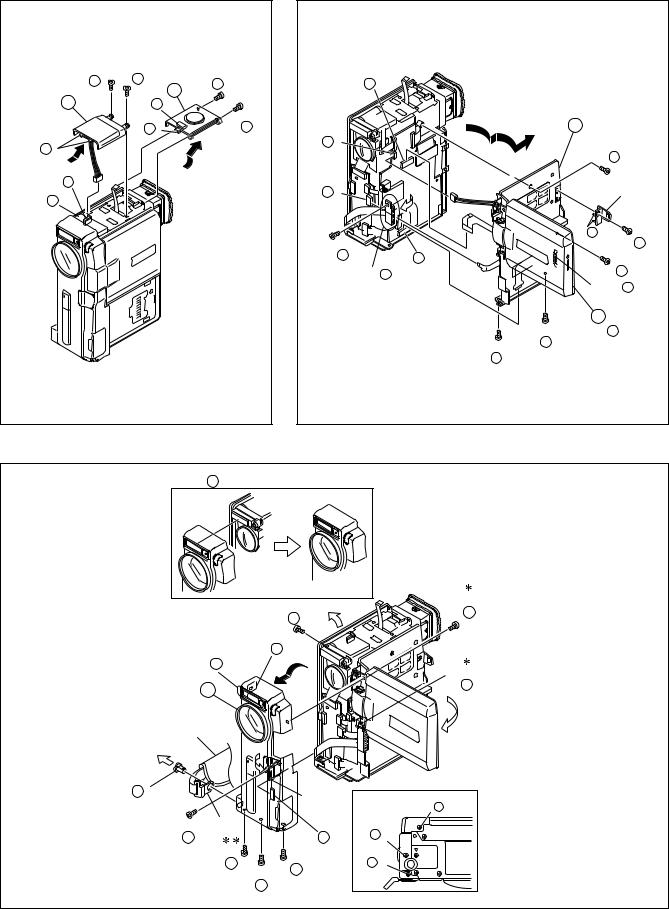
3 |
4 |
|
1 |
|
|
|
|
|
|
|
(S 2 ) |
(S 2 ) |
1 |
(S 1 |
) |
CN 4 c |
|
|
|
|
|
|
|
|
|
|
|
|
|
|
|
|
2 |
CN 1 a |
|
|
2 |
|
|
|
|
|
|
|
|
|
|
|
|
|
|
4 |
|
|
|
(L 1 ) |
|
|
(S 1 ) |
|
|
|
|
|
|
(L 2 ) |
|
|
|
CN 4 b |
|
|
|
|
14 |
|
|
|
|
|
|
|
|
|
|
||
|
|
|
|
|
|
|
|
(S 4 c) |
||
|
|
|
|
|
|
|
|
|
||
CN 2 a |
|
|
|
|
|
|
|
|
|
LOCK |
NOTE 2 |
|
|
|
CN 4 a |
|
|
|
|
(MONITOR) |
|
|
|
|
|
|
|
|
|
|
|
|
|
|
|
|
|
|
|
|
|
(L 4 ) |
12 |
|
|
|
|
13 |
|
|
|
|
(S 4 a) |
|
|
|
|
|
(S |
4 b) |
CN 4 |
d |
|
|
15 |
|
|
|
|
|
|
|
|
|||
|
|
|
|
|
NOTE 4 b |
|
|
|
(S 4 d) |
|
|
|
|
|
|
|
|
|
|
||
|
|
|
|
|
|
|
|
|
NOTE 4 c |
|
|
|
|
|
|
|
|
|
|
5 |
|
|
|
|
|
|
|
|
|
17 |
NOTE 4 a |
|
|
|
|
|
|
|
|
16 |
(S 4 |
e) |
|
|
|
|
|
|
|
|
|
|
|
|
|
|
|
|
|
|
|
(S 4 e) |
|
|
|
|
Fig. 1-3-1 |
|
|
|
|
|
Fig. 1-3-3 |
|
|
|
NOTE 3 b
6 (S 3 b)
(L 3 )
NOTE 3 b
3
GRIP BELT
 : 0.118N·m (1.2kgf·cm)
: 0.118N·m (1.2kgf·cm)  : 0.098N·m (1.0kgf·cm)
: 0.098N·m (1.0kgf·cm)
9 (S 3 c)
 10 (S 3 c)
10 (S 3 c)
NOTE 3 a |
|
|
|
|
COVER |
8 |
STUD |
|
|
|
|
||
|
|
|
|
(DV) |
(S 3 b) |
|
(HOOK) |
HOOK |
|
|
|
|
|
5 |
|
|
|
|
7 |
|
(S 3 a) |
|
|
|
|
CN 3 a |
(S 3 b) |
|
11 |
|
|
8 |
|
11 |
|
(S 3 d) |
|
|
(S 3 d) |
||
|
7 |
(S 3 |
b) |
|||
|
|
|
|
|||
|
|
|
|
|
|
|
|
|
(S 3 b) |
|
|
||
Fig. 1-3-2
1-4
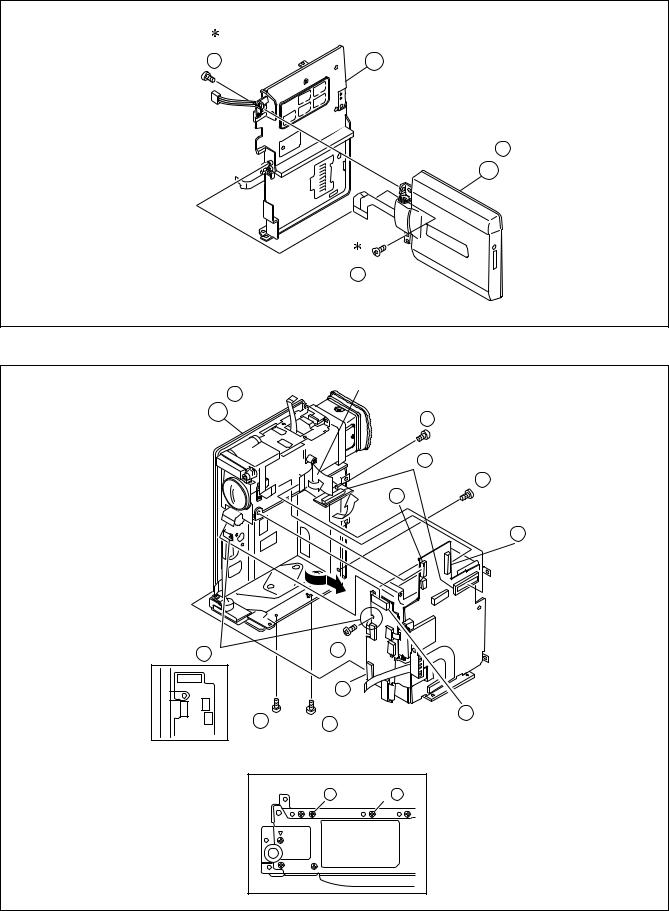
18
(S 5 a) |
4 |
NOTE 5
5
19 (S 5 b)
 : 0.198N·m (2.0kgf·cm)
: 0.198N·m (2.0kgf·cm)
Fig. 1-3-4
NOTE 6 a,b |
TAPE |
|
|
21 |
|
|
|
6 |
|
|
|
(S 6 |
b) |
|
|
|
|
||
|
CN 6 a |
22 |
|
|
|
|
(S 6 b) |
|
CN 6 c |
|
|
CN 6 b
|
20 |
|
|
NOTE 6 c |
(S 6 a) |
|
|
23 |
CN 6 e |
|
|
24 |
CN 6 d |
||
(S 6 b) |
(S 6 b) |
||
|
|||
|
23 |
24 |
|
|
(S 6 b) |
(S 6 b) |
|
|
Fig. 1-3-5 |
|
1-5
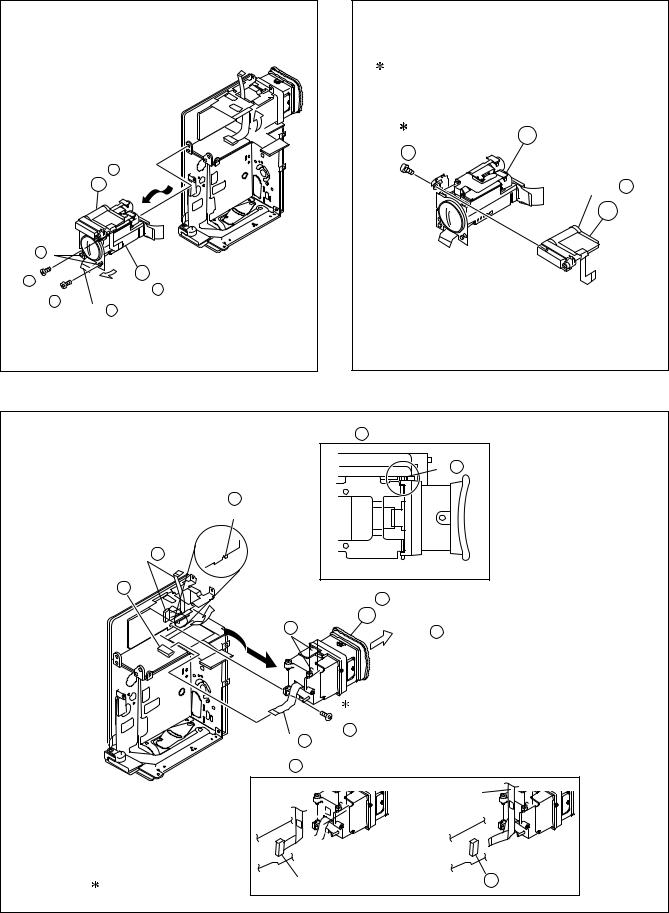
|
: 0.147N·m (1.5kgf·cm) |
|
|
27 |
7 |
|
(S 8 ) |
|
|
NOTE 7 a |
|
|
8 |
NOTE 8 |
|
|
8 |
(L 7 ) |
|
|
25 |
7 |
|
(S 7 ) |
|
|
NOTE 7 c |
|
|
26 |
|
|
(S 7 ) |
NOTE 7 b |
|
|
|
|
|
Fig. 1-3-6 |
Fig. 1-3-7 |
|
|
|
|
NOTE 9 b |
|
|
|
(L 9 ) |
||
NOTE 9 b |
|
|
|
SWITCH |
|
|
|
NOTE 9 a |
|
|
|
|
<TOP VIEW> |
||
CN 9 a |
NOTE 9 d |
|
|
|
|
||
(L 9 ) |
9 |
|
|
NOTE 9 |
b |
||
|
|||
|
28 |
|
|
(S 9 ) |
|
|
NOTE 9 c |
|
|
NOTE 9 a |
|
|
|
FPC |
|
|
or |
: 0.098N·m (1.0kgf·cm) |
CN803(AUDIO) |
CN 9 b |
|
Fig. 1-3-8 |
|
1-6

29
(L 10 b) |
(S 10 a) |
BRACKET
(TOP)
NOTE 10 b
(L 10 a)
|
|
|
|
10 |
|
|
32 |
|
|
|
|
|
|
(S 10 b) |
|
|
|
|
SWITCH |
|
|
SPACER |
|
|
|
|
|
|
|
|
|
|
|
|
NOTE 10 a |
|
|
|
30 |
|
|
|
|
|
|
(S 10 b) |
|
|
|
|
|
|
|
|
|
|
|
|
|
|
|
31 |
|
: 0.098N·m (1.0kgf·cm) |
|
|
|
(S 10 b) |
|
||
|
|
|
Fig. 1-3-9 |
|
|
|
|
NOTE 11 e, 12 |
|
|
|
|
|
|
|
|
|
13 |
|
|
|
|
|
|
|
|
BRACKET |
|
|
|
|
|
|
|
(MECHA) |
|
|
|
|
|
|
|
|
37 |
|
|
|
|
|
|
|
(S 13 b) |
CN 12 b |
|
|
|
|
|
|
|
|
||
|
|
(L 13 ) |
|
|
|
CN 12 a |
|
|
|
|
|
|
|
|
|
|
|
36 |
|
|
|
|
|
|
|
(S 13 a) |
38 |
|
|
|
35 |
NOTE 11 b CN 11 c |
|
|
(S 12 b) |
||||
(S 13 b) |
|
|
|||||
CN |
11 e |
34 |
|
|
|
|
|
(S 12 a) |
|
|
|
|
|||
|
|
|
|
|
|
||
CN 11 a |
|
|
|
NOTE |
11 a |
12 |
|
|
|
|
|
|
|||
|
|
|
(L 12 ) |
NOTE 11 a |
|
|
|
SHIELD 33 PLATE
11
(S 11 )
CN 11 b
NOTE 11 c
CN 11 d
CN 11 d
Fig. 1-3-10
1-7
